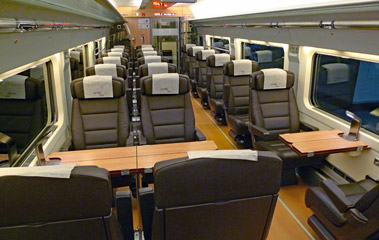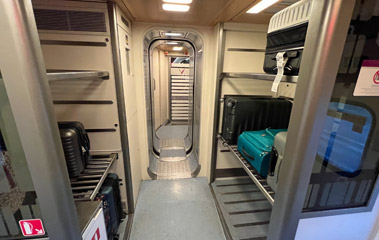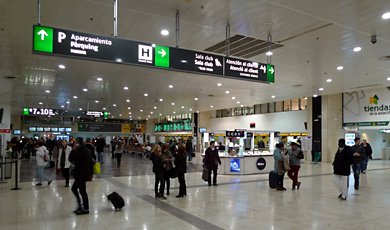Madrid & Barcelona to Perpignan, Avignon, Marseille, Lyon from €29
Until December 2022, high-speed trains from Spain into France were run as a joint venture by Renfe (Spanish Railways) and SNCF (French Railways). SNCF supplied TGV Duplex trains for Paris-Barcelona, Renfe supplied type S100 AVE trains for the daily Barcelona to Lyon and Madrid/Barcelona to Marseille trains.
In 2022 SNCF unilaterally ended their 9-year co-operation with Renfe and continued running the Paris-Barcelona TGVs on their own. Renfe were unable to operate into France without SNCF's help, so the Barcelona-Lyon and Madrid-Barcelona-Avignon-Marseille AVE trains were discontinued in December 2022.
However, Renfe now has an operating licence for France and they reintroduced these AVE routes in July 2023. Renfe and SNCF are now competitors, so these AVEs won't show up on SNCF's website. AVEs & TGVs both show up on websites which connect to both SNCF & Renfe such as www.raileurope.com and www.thetrainline.com.
AVE is the Spanish Railways brand name for its high-speed trains, of which there are various types. It stands for Alta Velocidad Española (Spanish High-Speed) and it's also the Spanish for bird. The S100 AVEs were originally used on the Madrid-Seville high-speed route in the 1990s, a number of them were refurbished & equipped with the French signalling system for use on services into France. They are spacious, smooth and comfortable, a pleasure to travel on.
![]() Travel tips: Luggage, WiFi, food & drink...
Travel tips: Luggage, WiFi, food & drink...
![]() How to check train times, fares & tickets
How to check train times, fares & tickets
Train times 2025
What are the trains like?
AVE-S100 trains have 1st & 2nd class seats (called estandar and confort by Renfe) & a cafe-bar. The train is air-conditioned with power sockets at all seats & free WiFi. It can run at up to 300 km/h (186 mph) on high-speed lines, which are built to standard gauge even in Spain, where classic lines are of Iberian gauge.
 |
|
An S100 AVE, seen at Seville. |
Travel tips
-
Should you go 1st or 2nd class?
2nd class (which Renfe calls standard or estandar) is absolutely fine, there's no need to pay extra for 1st class unless you want to.
1st class (which Renfe calls comfort or confort) merely means more leg and elbow room, with seats arranged 2+1 across the car width rather than 2+2. However, that means there are solo seats and tables-for-two on one side of the aisle in 1st class which are great if you're travelling alone or as a couple. 1st class is usually quieter with more laptops tapping, 2nd class is often busier with more families and kids.
Note that Basico, Elige and Premium are fare types, not classes. The Basico fare gets you standard (2nd) class, the Elige fare also gets you standard class but with more flexible ticket conditions, unless you upgrade to Elige Comfort, which gets you a comfort (1st) class seat. Got that? Good! That's Renfe logic. The Premium fare includes access to the Sala Club lounge at Madrid & Barcelona and a fully-flexible ticket, but premium fares aren't available on these AVE trains to France.
-
Boarding your train
There's no check-in, just be on board the train a minute before departure time when the doors close. At Spanish stations including Madrid Atocha & Barcelona Sants there is a simple and usually fairly quick baggage X-ray check before entering the departures area and your ticket may be checked before boarding, it only takes minutes, but don't turn up with seconds to spare. There is no X-ray check at French stations.
-
Luggage, bicycles & pets
Like any European train, you take your luggage in with you and stick it on any suitable rack near your seat or above your seat, see the photo below. Nobody weighs it or measures it, so no worries.
Dogs under 10 Kg in a pet carrier are carried for a small fee, see Renfe.com for details. Dogs over 10 kg are not carried.
Bikes are carried if packaged in a container, free of charge up to a certain size, at extra cost if larger, see Renfe.com for details.
-
Seat reservation is compulsory on all Spain-France high-speed trains and tickets come with a reserved seat automatically included.
-
Interrail & Eurail passes: Interrail & Eurail passes are accepted, reservation required for a small fee. Passholder reservations can now be made online, see the France > Spain by AVE section or the Spain > France by AVE section on the Interrail/Eurail reservations page.
-
Food & drink
The cafe-bar car serves snacks, hot dishes, coffee. soft drinks, beer & wine. You are of course free to bring your own food and drink along to eat & drink in your seat, even a beer or bottle of wine if you like.
-
WiFi & power outlets
There are power outlets at all seats and free WiFi, the network is PlayRenfe. 3G & 4G mobile data works fine along most of the relevant routes.
Times, fares & tickets
-
Fares from Barcelona to French cities start at €25 in 2nd class or €45 in 1st class.
These advance-purchase fares vary like air fares, specified train only, limited or no refunds or changes, book early for the best prices.
Booking typically opens 4 months ahead, but it can be as little as 60 days when the mid-December timetable change shrinks the booking horizon.
-
You can buy tickets for these trains at www.raileurope.com or www.thetrainline.com, both easy to use, in €, £ or $, small booking fee. The advantage of using these third party retailers is that they also connect to SNCF (French Railways) and other operators so (for example) you can see all trains between Barcelona, Perpignan, Nimes and Montpellier, whether run by SNCF or Renfe. Within Spain, they'll show competing Ouigo and Iryo trains as well as Renfe ones.
-
You can of course buy tickets for these AVEs at Renfe's own website www.renfe.com, in €, it's quirky and occasionally rejects overseas payment cards, see my advice for using it, but there's no booking fee. Renfe's website only shows Renfe services, it won't show competing trains run by SNCF or other operators.
Route map
Scenery & sights
These trains pass some great scenery. I describe the Barcelona-Lyon & Barcelona-Avignon-Marseille routes below as if you're travelling east from Barcelona to France, but you see the same sights in either direction. Obviously when I say something is on the left hand side, it'll be on the right hand side when going west.
Watch the video: Click here
The video shows a journey from Barcelona to Paris on a French TGV Duplex, but the AVEs from Barcelona to French regional cities take exactly the same route past exactly the same scenery as far as Montpellier if going to Avignon or Marseille, and all the way to just south of Lyon if going to Lyon.



















